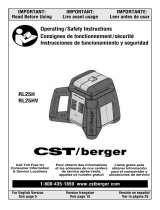
15
GB
Installing the Coin Cell Battery
A coin cell battery should already be installed in the bottom of
the laser unit (Figure
D
3
) so it is ready to use the Bluetooth
®
connection, after you remove the battery protector. To remove the
battery protector on your new laser, or replace the coin cell battery in
the future, follow these steps.
1.
Carefully turn the laser upside down.
2.
On the bottom of the laser, unscrew the battery compartment
cover, which is marked 3V CR2430.
3.
Lift off the battery compartment cover and remove the coin cell
battery.
4.
If your laser is new, remove the battery protector (round disc), and
then re-insert the same coin cell battery.
5.
If your laser is not new, insert a new 3V CR2430 coin cell battery into
the battery compartment.
6.
Carefully place the battery compartment cover back in the correct
position and use the screws to secure the cover in place on the
bottom of the laser unit.
THE BLUETOOTH® WORD MARK AND LOGOS ARE REGISTERED TRADEMARKS OWNED
BY BLUETOOTH SIG, INC. AND ANY USE OF SUCH MARKS BY DEWALT IS UNDER LI-
CENSE. APPLE AND THE APPLE LOGO ARE TRADEMARKS OF APPLE INC., REGISTERED
IN THE U.S. AND OTHER COUNTRIES. APP STORE IS A SERVICE MARK OF APPLE INC.,
REGISTERED IN THE U.S. AND OTHER COUNTRIES. GOOGLE PLAY AND THE GOOGLE
PLAY LOGO ARE TRADEMARKS OF GOOGLE INC.
Installing Batteries in the Remote
Load new AAA batteries into the remote so you can use it with the
laser unit.
1.
On the bottom of the remote, lift up the latch to open the battery
compartment cover (Figure
C
1
).
2.
Insert two new, high-quality, name brand AAA batteries, making
sure to position the - and + ends of each battery as noted inside
the battery compartment (Figure
C
2
).
3.
Push the battery compartment cover closed until it snaps into
place (Figure
C
3
).
Charging the Detector
The Digital Laser Detector is powered by a Li-ion battery. To charge
the battery.
1.
Insert the USB end of the charging cable into a USB port (Figure
E
1
).
2.
On the Detector, pull the Micro USB port cover (Figure
E
2
) off
and to the side.
3.
Insert the Micro USB end of the charging cable into the
Detector's Micro USB port (Figure
E
3
).
4.
Allow the Detector time to fully-charge. The LED on the Detector
will remain Red as the battery is charging (Figure
F
13
).
5.
When the LED on the Detector turns Green, remove the
charging cable.
Operating Tips
• To extend battery life per charge, turn the laser off when it is not
in use.
• To ensure the accuracy of your work, check the laser calibration
often. Refer to Calibrating the Laser.
• Before attempting to use the laser, make sure the tool is positioned
on a relatively smooth, secure surface.
• Always mark the center of the laser line or dot. If you mark different
parts of the beam at different times you will introduce error into
your measurements.
• To increase working distance and accuracy, set up the laser in the
middle of your working area.
• When attaching to a tripod or wall, mount the laser securely.
• When working indoors, a slow rotary head speed will produce
a visibly brighter line, a faster rotary head speed will produce
a visibly solid line.
• To increase beam visibility, wear Laser Enhancement Glass es
(Figure
S
) and/or use a Laser Target Card (Figure
R
) to help find
the beam.
• Extreme temperature changes can cause movement or shifting of
building structures, metal tripods, equipment, etc., which can effect
accuracy. Check your accuracy often while working.





















